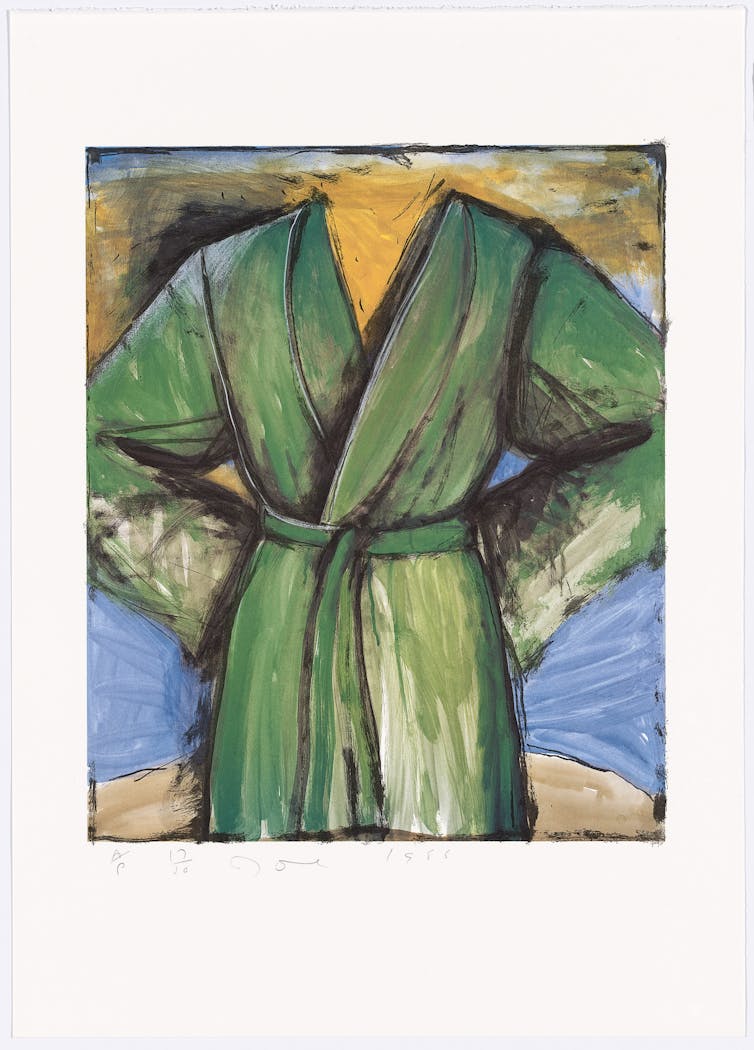Art or Drawing Class or Classes or Department Drop or Dropped My or Her or Your Robe or Bathrobe
Jim Dine was a heroic effigy in American fine art schools in the 1960s. Linked to the Popular Fine art movement, his images of everyday objects empowered a generation of immature artists with the thought that art could transform the mediocre, turning the humdrum and the commonplace into something magical. It offered a way into images and objects, making a very personal perspective from resources readily at hand.

Some of Dine's signature attractions were his reverence for the process of making fine art, his celebration of the tools of art — saws, brushes and hammers — and his energetic arroyo. His images of hearts and tools, Pinocchio and bathrobes, were rooted in the experiences of everyday life but were enlivened by their placement within a vibrant gestural, painterly ambience. Information technology was also like shooting fish in a barrel to emulate, and many did.
Dine'south dedication to printmaking was another factor in his popularity. His legendary "attacks" on his etching plates with angle grinders and power tools, the ballsy play of his multiple colour versions of his lithographs, and his virtuosity with chisels and carving tools when making relief prints ensured him a following in the days when printmaking was at its zenith.
It was a medium that could provide art for anybody, by embracing new reproductive technologies and simultaneously puncturing the elitism and pomposity of "high art". Printmaking equally practised past Andy Warhol, Robert Rauschenberg and Jim Dine was egalitarian, hip and edgy. Unsurprisingly, it establish many devotees.
Even so, the key element that secured Dine's following amidst aspiring artists in the swinging '60s was his autobiographical, diaristic approach to making fine art. The objects he chose to represent were either linked to his past or locked into his current interests. The tools he depicted were an repeat of a childhood spent in his father's hardware store in Cincinnati, the heart was a valentine for his wife, and the bathrobe became a representation of self, constantly re-invented and re-imagined in paintings, prints and drawings.

Born in 1935 in Ohio, Dine arrived in New York in 1959. There he made his mark as one of the progenitors of "happenings", performative artworks that blended theatre, the visual arts, music and ritual.
Along with Claes Oldenburg and Allan Kaprow, Dine became well known for the hybrid artworks he performed at the Judson Gallery. In the studio he continued to brand works with a similar hybrid spirit, combining actual objects with an overlay of gestural mark making while developing his iconography of hearts, bathrobes and other everyday objects.
Although he claimed never to accept worn one, Dine first embraced the heroic form of the vacated robe as a subject area in 1964 and gave his paintings and prints titles that often referred to himself, such as "Double Isometric Cocky-Portrait". Without the human being trunk to give the garment a betoken of specificity or individuality, the robe became an lowest every bit much as a cocky-portrait. Every bit a result Dine was able to recast the paradigm every bit a portrait of Bill Clinton, or to subjugate its human referent birthday with a title such as "Untitled (black robe)".
"The mighty robe I", fabricated in 1985 with master printmaker Hansjörg Mayer in Stuttgart, seems to depict the artist every bit conquering hero. Although without a body, head or hands, he stands resolute and confident. The stained crenel of his absent-minded breast presents an internal glow of strength and power and the robe acts as a kind of cape that provides superhuman powers. Seemingly with his tongue firmly planted in his cheek, this epitome of the hero in his own bathroom is a peculiarly human and poignant portrait of the artist at age 50.

Dine continued to exploit the bathrobe motif for over 30 years. The current exhibition at the National Gallery of Victoria, Jim Dine: A Life in Print, features numerous variations such as "Two Florida bathrobes" 1986, "The kindergarten robes" 1983, "Blue robe" 2007 and "Foam and ruby robe on stone" 2010.
The exhibition features more than 100 prints covering 45 years of the artist's work, selected from an extraordinary donation of 249 artworks Dine has made to the National Gallery of Victoria. The artist has made similar gifts to the British Museum and the Boston Fine Arts Museum, no doubt in the hope that future generations of young students seeking a indicate of entry into making images and objects might find sustenance in his comprehend of the everyday. Allow's hope and so!
Jim Dine: A Life in Print is showing at the National Gallery of Victoria, Melbourne, until Oct 15 2017.
0 Response to "Art or Drawing Class or Classes or Department Drop or Dropped My or Her or Your Robe or Bathrobe"
Post a Comment